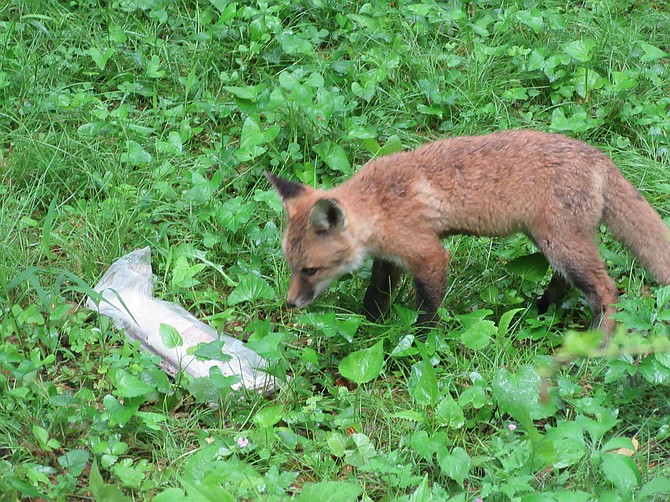When raising young, parenting foxes bring things to the den for the kits to chew on. A favorite seems to be newspapers left in driveways. In my neighborhood, we have had many instances of "disappearing newspapers," only to find many with tooth-pocked plastic bags near fox dens. Photo by Glenda Booth
Foxes are very adaptable to human environments, Fairfax County wildlife biologist Erin Thady told 70 attendees at a Dec. 6 Zoom talk sponsored by the Friends of Mason Neck State Park. Wily and agile, they can survive in suburban areas because of available food and denning sites provided by human-modified environments.
Urban landscapes attract rodents, Thady said. Resourceful hunters with excellent senses of sight, smell and hearing, foxes eat small mammals like mice, voles, squirrels and rabbits in the winter. In spring and summer, they also eat berries, caterpillars, crayfish and birds. “Once they find reliable food sources, they stay around,” Thady explained. Adult foxes have few predators in the area and their populations are stable.
Virginia has both red and gray foxes. Red foxes weigh nine to 12 pounds, about the same as a cat; less common gray foxes, around eight pounds. Grays have a distinctive black stripe on their tails. With their semi-retractable claws, they can climb trees; hence, they are nicknamed “tree foxes.” Most foxes generally sleep during the day and are more active at night than in daytime.
Non-migratory animals, foxes tend to have a home range of one to five miles. As “habitat generalists,” red foxes can thrive in a variety of environmental conditions. Gray foxes prefer more specialized environments, like forests and wetlands.
People can easily confuse foxes with coyotes, another common animal in Virginia. Red foxes have a white tip on their tails and hold their tail out. Coyotes have a dark tail tip and point their tails down toward the ground. Foxes have a “prancing gait” and coyotes a “lumbering gait,” Thady offered.
In the winter, Thady’s office gets alarm calls about high-pitched screams piercing the night. These howls can be the female or vixen mating or rival males confirming territory, she explained. Foxes breed from December to March, and females have on average seven blind and deaf kits who emerge from their dens in two to three months.
Living with Foxes
Foxes are naturally wary of humans and have a natural tendency to flee upon encountering people. “They are not dangerous to humans unless captured,” she advised. A strong caution: Do not feed wildlife or they could lose their natural fears and ability to hunt. People should also avoid what she called “inadvertent feeding,” such as having unsecured garbage containers, feeding cat colonies and putting pet food outdoors.
Adept diggers, foxes will den under low porches, decks and sheds and many return to the same den every year. She advised people to avoid disturbing dens until late summer when grown kits can hunt for themselves. She suggested several “humane harassment” techniques to move them, if necessary, like putting loose mulch, hot pepper, urine-soaked kitty litter, sweaty sneakers, reflective tape and shiny balloons at the den’s entrance.
On fox-pet interactions, she said, “Foxes are not very interested in cats, but kittens or small cats could become prey. It’s best to keep cats inside.” Dogs and foxes have “a natural aversion,” she asserted. Most dogs are not at risk of a fox attack unless the dog is threatening the fox’s litter. However, miniature dogs could be “susceptible to foxes.” She recommended not leaving dogs outside unattended.
Evidence of digging could be the sign of a fox, but it could also be raccoons or skunks. When the ground is wet, wildlife might dig for grubs or earthworms. Deterrents she suggested include chicken wire spread and secured over an area, clanging pots and pans and spraying wildlife with the water from a hose.
“Everyone has a different tolerance level for wildlife,” she offered and invited people to reach out to her office for advice on how to “co-exist successfully.”
For information and advice:
Fairfax County Wildlife Management: Dr. Katherine Edwards, Katherine.Edwards@fairfaxcounty.gov, 703-246-6868; Erin Thady, Erin.Thady@fairfaxcounty.gov, 703-324-0248; Ethan Chapmon: Ethan.Chapmon@fairfaxcounty.gov, 703-324-0246
Fairfax County Animal Protection Police (non-emergency), 703-691-2131
Virginia Wildlife Conflict Helpline: 855-571-9003



